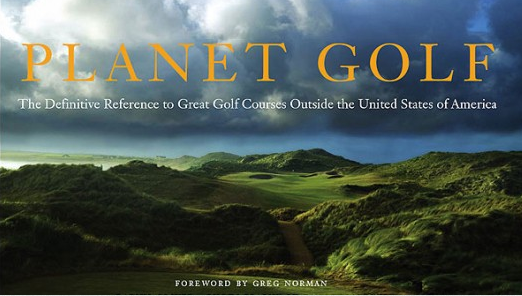Q&A With Darius Oliver, Part 1
/ Darius Oliver has authored three of my favorite reference books, most notably the stunning Planet Golf and Planet Golf USA books, the product of five years seeing and playing courses across the globe, studying more than 900 layouts in 45 countries. He is currently the architecture editor of Australian Golf Digest magazine, operator of the Planet Golf website and a design consultant.
Darius Oliver has authored three of my favorite reference books, most notably the stunning Planet Golf and Planet Golf USA books, the product of five years seeing and playing courses across the globe, studying more than 900 layouts in 45 countries. He is currently the architecture editor of Australian Golf Digest magazine, operator of the Planet Golf website and a design consultant.
In preparation for the upcoming Australian Open, I've asked Oliver some questions to prepare us for the week.
GS: For the next two weeks Australia will be in the world spotlight with The Lakes and Royal Melbourne. First, your take on The Lakes before and after Mike Clayton's work there?
DO: The Lakes is much better now than it used to be, and I think the only players who would disagree with that statement are professionals or those who like their golf to be tough and relentless.
Prior to Clayton’s involvement The Lakes was really the knee-jerk club of Sydney. They had consultant architects over an extended period whose only answer to technology was to keep adding bunkers and pinching fairways. The last incarnation of the course (before Clayton’s work started) was tight and hard but pretty poor. Now you have broad, strategic fairways and uniform bunkering and the layout just looks right for that particular property.
That said, I’m not pretending the current layout is perfect, certainly the Kikuyu fairways are far from ideal and there is the odd green contour that perhaps teeters on the edge of being reasonable. For regular play or the aim of making an interesting championship, however, it’s really good and a vast improvement.
Funny, but I like to contrast The Lakes with places like Erin Hills and Chambers Bay, which are similarly built for championship play but much more difficult for average golfers. Clayton could have easily made The Lakes much harder, but by doing so he would have destroyed the inherent interest for regular members. I like the fact that last year the winning score was around 20 under par, but nobody in Australia really cared or held that against the course. There is no doubt that you could improve Chambers Bay, for example, but by doing so you would definitely make the course easier, and I’m not sure how the USGA would handle that concept.
GS: There have been troubles with course setup at the Australian Open last decade, with complaints last year from Greg Norman about The Lakes. Who is doing the setup these days and are we past those years or do the likes of Tiger, Couples and Scott face the possibility of similar shenanigans?
DO: The complaints last year were extremely shortsighted, because the professionals were playing on immature fairways and greens that had been absolutely hammered by heavy rains. Those who expected firmer conditions obviously don’t understand the agronomy of a golf course.
The previous troubles you refer to relate to the heavy winds at NSW Golf Club in 2009 and the famous Open at Victoria in 2002, when play was cancelled on a calm Spring day because organizers had lost the greens. I believe the industry here in Australia has learned from that episode and Tiger, Couples etc are unlikely to encounter similar issues this year. In fact, there are some here that feel we have been so spooked by 2002 that courses are no longer prepared for championships as close to the edge as is ideal. I love watching great players on slippery greens, and I just hope that the weather leading-in to the Open this month is favorable for firm and fast conditions. GS: Your two Planet Golf books, while big, beautiful coffee table books, are filled with sharp observations and something unusual for such lavish productions: insightful, constructive architectural criticism. How have your course reviews been received in a world so hypersensitive to that kind of writing?
GS: Your two Planet Golf books, while big, beautiful coffee table books, are filled with sharp observations and something unusual for such lavish productions: insightful, constructive architectural criticism. How have your course reviews been received in a world so hypersensitive to that kind of writing?
DO: Well that’s a hard question to answer, because it depends who you ask. Obviously there are some architects who love my books, and others who wish they had never been published. It’s not just the books, some of my columns in Australian Golf Digest and on the Planet Golf website have upset architects and that’s not something I relish or enjoy.
My view, however, is that golf course designers are rarely held properly to account and if we hope to improve the standard of golf courses (which is my aim) then more critical analysis of their work is needed. This view was formed by living in Australia, where for years the great old courses were obviously superior to the modern layouts being built here yet the same modern architects were seemingly winning every design contract. I just never understood why golf writers and magazines lavished praise on every new course built, when they all had such obvious flaws.
I must say, that with some exceptions, most of the golf clubs and golf operators around the world have been far less sensitive to my comments than the architects themselves. I’m rarely denied access to a golf course and have been pleased that few administrators have confused my commentary on their golf course as criticism of their golf club. They know my focus is entirely on the golf holes and thankfully many regard critical commentary as being constructive in some way. That said, the one thing that still bugs me about golf is how some managers think hospitality can buy them a good review. GS: You've recently been to China and wrote about the Coore-Crenshaw course on Hainan Island. Your general impressions of the development scene there, especially in terms of quality architecture?
GS: You've recently been to China and wrote about the Coore-Crenshaw course on Hainan Island. Your general impressions of the development scene there, especially in terms of quality architecture?
The standard of golf in China is definitely improving, but is still way below what we would expect in places like America, the UK and Australia. There are a number of reasons for this, from unsophisticated clients and ‘dodgy’ construction companies through to architects who treat golf as a business rather than a passion. Brand, price and having the right connections are essential in China. If you have these, then the lack of high-quality courses in your portfolio won’t really matter.
My goal is to help introduce more quality architects into the Chinese market, and I realize it’s a slow education process that is going to take time. I have a new book coming out next year, which will be translated into Mandarin and distributed widely across the industry, and have also started writing monthly columns on design for one of the biggest golf magazines in China. Ultimately it’s up to Chinese developers to seek out our advice, and hopefully the success of places like Shanqin Bay (Coore & Crenshaw) will encourage more of them to want similar standard golf courses.
At the moment China is in a state of paralysis, the recent government crackdown on golf has stopped many developers in their tracks as they wait to see what changes, if any, will be made to the industry. I believe the halt has been beneficial, as its given pause for thought and reflection. We know of several developers reconsidering their design appointments in an effort to produce better golf.
China is an odd place, and when you have a developer firing his design team because they won’t build an island par three on a mountainside property you start to appreciate the challenge involved in creating great golf there. It’s about baby steps right now, and that Coore & Crenshaw project is the first true world-class golf course in the country. It was much needed and long overdue.
Coming next week Darius offers unique insights into Royal Melbourne, the state of Australian golf and how to plan an affordable golfing trip Down Under.











